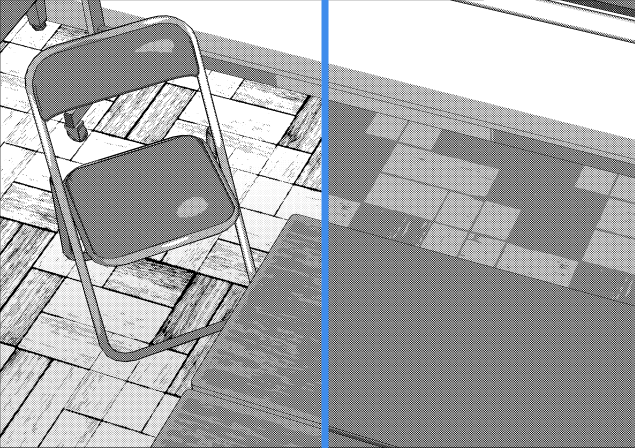3. Line Art & Flat Colors
A. Linework
Once I’ve finished the draft lines, I proceed to the detailed linework.
I’ve been working at 100dpi so far, but I switch to 350dpi at this stage. I adjust the resolution in the [Edit] menu > [Change Image Resolution] dialog box.
I reduce the opacity of the draft lines to around 20–50%. Above that, I make a new layer for the linework.
I’ll use the “Traditional pencil” brush that I made in part 1. I use a deep brown for the lines and set the brush size to around 8 or 9 px. As I draw, I rotate the image and adjust the stabilization settings. To begin with, I simply follow the lines of the draft.
After drawing the linework, I lighten or erase the parts where the lines are overlapping, such as around the eye area.
In the [Layer] palette, I right click the linework layer and select [Layer Mask] > [Mask Selection] to create a mask over the layer.
Then I select transparency as the drawing color and select the layer mask icon.
When you draw with transparency on a layer mask, it creates a mask over the drawn area.
In the following image, I turned on [Show Mask Area] so you can see where I drew.
For the overlapping hair, I create an opaque mask to hide the unnecessary lines.
Process GIF:

You can also create layer masks for folders.
I create a few more layer masks to hide unwanted lines while remaining aware of the layer order.
I draw the lines for the interior of the umbrella using the following method.
(1) With the Traditional pencil brush and the [Figure] tool > [Direct draw] > [Straight line] sub tool, I draw the woven frame.
(2) I right-click the layer with the umbrella frame lines, then select [Selection from Layer] > [Create Selection] to make a selection area of the drawn parts.
(3) In the [Selection] menu, I select [Expand selected area] and expand the area by 4px.
(4) Then, I make a new layer and select the [Fill] icon on the [Selection Launcher] to fill the selection area.
(5) I make another selection area of the original frame lines using the same process as step 2.
(6) I go back to the layer I made in step 4, then go to the [Edit] menu > [Clear]. This removes the inside color to leave only the outside lines.
I separate my line art into these folders to make the painting stage easier.
I intend to add different effects to each folder. Inside the folders, the line art is divided further into parts.
This is my finished linework.
B. Flat colors
Using the folders I made earlier, I start to lay down the colors.
For this stage, I use the [Fill] tool set to [Refer other layers] and with the [Area Scaling] set to 2px. I use a brush for some parts too.
You can also fill in multiple missed gaps at once by using the [Paint unfilled area] sub tool. For a detailed explanation, please see the following tutorial.
I use the [Eyedropper] tool to pick up colors from the rough draft.
Now my flat colors are done.
























Comment